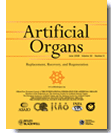|
Oxygen Consumption in a Hollow Fiber Bioartificial Liver - Revisited

2004 International Society of Artificial Organs,
Blackwell Publishing, Inc.
By John F. Patzer II
Abstract
Oxygen consumption dynamics in a hollow fiber, hepatocyte-loaded bioartificial liver are investigated both theoretically and experimentally. The theoretical model is based upon the Krogh cylinder, which approximates the bioreactor as a collection of cylindrical elements comprised of an inner fiber lumen for media perfusion, the fiber wall through which oxygen can diffuse, and an annular region of hepatocytes surrounding the fiber. The primary nondimensional parameters that describe the system are: (i) the Peclet number, Pe, which is the ratio of convective oxygen transport through the lumen to diffusive oxygen transport to the fiber walls; (ii) the hepatocyte saturation parameter,  , which is the ratio of the inlet oxygen partial pressure to the Michaelis-Menten half-rate oxygen partial pressure; (iii) the Thiele modulus, , which is the ratio of the inlet oxygen partial pressure to the Michaelis-Menten half-rate oxygen partial pressure; (iii) the Thiele modulus,  2, which is the ratio of oxygen consumption rate to oxygen diffusion rate in the hepatocyte annulus; (iv) the hepatocyte permeability ratio, 2, which is the ratio of oxygen consumption rate to oxygen diffusion rate in the hepatocyte annulus; (iv) the hepatocyte permeability ratio,  31 , which is the ratio of oxygen permeability in the hepatocyte cell mass to oxygen permeability in the perfusing lumen medium; and (v) the hepatocyte annular thickness, 31 , which is the ratio of oxygen permeability in the hepatocyte cell mass to oxygen permeability in the perfusing lumen medium; and (v) the hepatocyte annular thickness, 3 , which is the ratio of the exterior hepatocyte annular radius to the fiber lumen radius. Only Pe' and 3 , which is the ratio of the exterior hepatocyte annular radius to the fiber lumen radius. Only Pe' and  are easily manipulated operating variables. , are easily manipulated operating variables. ,  31 , and 31 , and  3 are engineering design parameters that are set when a bioreactor is fabricated. The model results are expressed as the effective hepatocyte utilization ratio, Vratio, which is the ratio of the observed oxygen consumption rate to the intrinsic hepatocyte oxygen consumption rate. Large regions of Vratio > 0.9, which is deemed an acceptable effective hepatocyte utilization are found for parameter values consistent with standard hollow fiber cartridges used in bioartificial liver fabrication. The extent of the Vratio > 0.9 region increases to a plateau with increasing Pe, increases with increasing theta , decreases with increasing 3 are engineering design parameters that are set when a bioreactor is fabricated. The model results are expressed as the effective hepatocyte utilization ratio, Vratio, which is the ratio of the observed oxygen consumption rate to the intrinsic hepatocyte oxygen consumption rate. Large regions of Vratio > 0.9, which is deemed an acceptable effective hepatocyte utilization are found for parameter values consistent with standard hollow fiber cartridges used in bioartificial liver fabrication. The extent of the Vratio > 0.9 region increases to a plateau with increasing Pe, increases with increasing theta , decreases with increasing  2 , increases with increasing 2 , increases with increasing  31, and decreases with increasing 31, and decreases with increasing  3 . The theoretical results indicate that Vratio > 0.9 is found whenever the experimentally observed fractional oxygen consumption from the perfusing medium, 3 . The theoretical results indicate that Vratio > 0.9 is found whenever the experimentally observed fractional oxygen consumption from the perfusing medium,  O2, is less than 0.25. Combination of the theoretical and experimental results indicate that intrinsic, per cell oxygen consumption in the hollow fiber system may decrease as hepatocyte cell density increases and that this decrease may be due to lower intrinsic oxygen requirements in denser suspensions and not due to diffusion limitations in oxygen transport in the hollow fiber system as might be expected from twodimensional, monolayer culture oxygen consumption measurements. O2, is less than 0.25. Combination of the theoretical and experimental results indicate that intrinsic, per cell oxygen consumption in the hollow fiber system may decrease as hepatocyte cell density increases and that this decrease may be due to lower intrinsic oxygen requirements in denser suspensions and not due to diffusion limitations in oxygen transport in the hollow fiber system as might be expected from twodimensional, monolayer culture oxygen consumption measurements. 2 2
|
|




 , which is the ratio of the inlet oxygen partial pressure to the Michaelis-Menten half-rate oxygen partial pressure; (iii) the Thiele modulus,
, which is the ratio of the inlet oxygen partial pressure to the Michaelis-Menten half-rate oxygen partial pressure; (iii) the Thiele modulus,  2, which is the ratio of oxygen consumption rate to oxygen diffusion rate in the hepatocyte annulus; (iv) the hepatocyte permeability ratio,
2, which is the ratio of oxygen consumption rate to oxygen diffusion rate in the hepatocyte annulus; (iv) the hepatocyte permeability ratio,  31 , which is the ratio of oxygen permeability in the hepatocyte cell mass to oxygen permeability in the perfusing lumen medium; and (v) the hepatocyte annular thickness,
31 , which is the ratio of oxygen permeability in the hepatocyte cell mass to oxygen permeability in the perfusing lumen medium; and (v) the hepatocyte annular thickness, 3 , which is the ratio of the exterior hepatocyte annular radius to the fiber lumen radius. Only Pe' and
3 , which is the ratio of the exterior hepatocyte annular radius to the fiber lumen radius. Only Pe' and